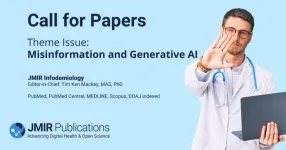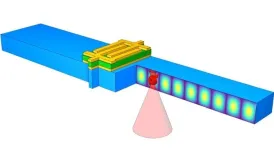(Press-News.org) NASA’s Atmospheric Waves Experiment, or AWE, mission is scheduled to launch to the International Space Station in November 2023, where it will make use of a natural, ethereal glow in Earth's sky to study waves in our planet's atmosphere.
Built by Utah State University’s Space Dynamics Laboratory in North Logan, Utah, AWE will be mounted on the exterior of the space station. From this perch, AWE will stare down toward Earth, tracking undulations in the air known as atmospheric gravity waves (AGWs).
Primarily originating in the lowest level of the atmosphere, AGWs may be caused by strong weather events such as tornadoes, hurricanes, or even thunderstorms. These weather events can momentarily push pockets of high-density air upwards into the atmosphere before the air sinks back down. This up-and-down bobbing often leaves behind distinctive ripples patterns in the clouds.
But AGWs continue all the way to space, where they contribute to what’s known as space weather – the tumultuous exchange of energy in the area surrounding our planet that can disrupt satellite and communications signals. AWE will measure AGWs at an atmospheric layer that begins some 54 miles (87 kilometers) in altitude, known as the mesopause.
“This is the first time that AGWs, especially the small-scale ones, will be measured globally at the mesopause, the gateway to the space,” said Michael Taylor, professor of physics at Utah State University and principal investigator for the mission. “More importantly, this is the first time we will be able to quantify the impacts of AGWs on space weather.”
At the mesopause, where AWE will make its measurements, AGWs are revealed by colorful bands of light in our atmosphere known as airglow. AWE will “see” these waves by recording variations of airglow in infrared light, a wavelength range too long for human eyes to see. At these altitudes our atmosphere dips to its coldest temperatures – reaching as low as -150 degrees Fahrenheit (-101 degrees Celsius) – and the faint glow of infrared light is at its brightest.
By watching that infrared airglow grow brighter and dimmer as waves move through it, AWE will enable scientists to compute the size, power, and dispersion of AGWs like never before. It was also designed to see smaller AGWs, detecting short-scale ripples in airglow that previous missions would miss.
“AWE will be able to resolve waves at finer horizontal scales than what satellites can usually see at those altitudes, which is part of what makes the mission unique,” said Ruth Lieberman, AWE mission scientist at NASA’s Goddard Space Flight Center in Greenbelt, Maryland.
From its vantage point on the space station, AWE’s Advanced Mesospheric Temperature Mapper (AMTM) instrument will scan the mesopause below it. AWE’s AMTM consists of four identical telescopes, which together comprise a wide-field-of-view imaging radiometer, an instrument that measures the brightness of light at specific wavelength ranges. The relative brightness of different wavelengths can be used to create temperature maps, which in turn reveal how AGWs are moving through the atmosphere. It will be the most thorough study of AGWs and their effects on the upper atmosphere ever conducted.
As a payload headed to the space station, AWE was required to hold four crucial safety reviews. The mission was successfully certified as a station payload at its last review in July 2023. Part of this certification involved “sharp edge” testing with astronaut gloves to ensure safety during AWE’s installation and maintenance on the exterior of the space station.
AWE is the first NASA mission to attempt this type of science to provide insight into how terrestrial and space weather interactions may affect satellite communications and tracking in orbit.
Following AWE’s installation on the International Space Station, the team’s focus will be to share the instrument’s data and results with the science community and the public. More information about AWE is available on the mission website: https://www.awemission.org/.
By J. Titus Stupfel, NASA’s Goddard Space Flight Center
END
AWE launching to space station to study atmospheric waves via airglow
2023-10-26
ELSE PRESS RELEASES FROM THIS DATE:
Research advances toward goal of net zero carbon emissions
2023-10-26
Scientists may be on the verge of taking a big step closer to the net-zero carbon emissions goal, thanks to University of Houston research into algae. Hidden potential is being revealed in the major algae studies at the microbial products lab, located at UH at Sugar Land.
The research project is detailed in a newly published article in Green Chemistry, a journal of the Royal Society of Chemistry.
Venkatesh Balan, associate professor of engineering technology in UH’s Cullen College of Engineering’s Division of Technology, is ...
JMIR Infodemiology call for papers theme issue on misinformation and generative AI
2023-10-25
JMIR Infodemiology Editor-in-Chief: Tim Ken Mackey, MAS, PhD welcomes submissions to a special theme issue “Exploring the Intersection Between Health Information, Disinformation, and Generative AI Technologies.”
JMIR Infodemiology, currently indexed in PubMed Central, PubMed, Scopus, DOAJ, and CABI, is a peer-reviewed premier journal in the field of infodemiology, health information, data science, and misinformation and is inviting submissions from different disciplines of health communication, public health, informatics, data science, social ...
Yale School of Nursing receives historic gift for scholarships
2023-10-25
Yale School of Nursing (YSN) has received a landmark gift — the largest single donation in the school’s history. The $11.1 million gift from a generous anonymous donor was announced on Sept. 21 by Azita Emami, dean of the Yale School of Nursing, at an event kicking off the school’s yearlong centennial celebration (September 2023–May 2024).
This endowed gift will support the YSN Community Scholars program, providing full-tuition scholarships to six students each year in the Master of Science in Nursing ...
Birmingham rare earth magnet recycling technology selected as a Minerals Security Partnership project
2023-10-25
A Principals’ meeting of the Minerals Security Partnership (MSP) has confirmed that HyProMag Ltd, which uses a technology developed by the University of Birmingham’s Magnetic Materials Group has been selected as one of the projects that will help to develop responsible critical mineral supply chains.
Formed in 2022 by 14 governments, the Mineral Security Partnership (MSP) aims to ensure adequate supplies of minerals such as rare earths to meet net zero-carbon goals. It aims to support public and private sector investments building diverse, secure, and responsible global critical minerals supply chains.
HyProMag was one ...
Novel small molecule 5D4 disrupts several molecular pathways, including MYC, that lead to cancer growth
2023-10-25
Researchers at Baylor College of Medicine have identified a small molecule named 5D4 that can suppress the growth of breast and ovarian cancers in animal models. 5D4 works by binding to TopBP1 protein in cancer cells, disrupting its interactions with several pathways that promote cancer growth. Combining 5D4 with another cancer inhibitor, talazoparib, enhances the effectiveness of the anti-cancer activity. The study, published in the Proceedings of the National Academy of Sciences, strongly supports continuing the investigation toward further developing this strategy for clinical use.
“Cancer development involves many steps of genetic alterations and signaling ...
Unlocking pathways to break down problem proteins presents new treatment opportunities
2023-10-25
When targeting problem proteins involved in causing or spreading disease, a drug will often clog up a protein’s active site so it can’t function and wreak havoc. New strategies for dealing with these proteins can send these proteins to different types of cellular protein degradation machinery such as a cell’s lysosomes, which act like a protein wood chipper.
In a new study published in Science on Oct. 20, Stanford chemists have uncovered how one of the pathways leading to this protein “wood chipper” works. In doing so, they have opened the ...
Using sound to test devices, control qubits
2023-10-25
Acoustic resonators are everywhere. In fact, there is a good chance you’re holding one in your hand right now. Most smart phones today use bulk acoustic resonators as radio frequency filters to filter out noise that could degrade a signal. These filters are also used in most Wi-Fi and GPS systems.
Acoustic resonators are more stable than their electrical counterparts, but they can degrade over time. There is currently no easy way to actively monitor and analyze the degradation of the material quality of these widely used devices.
Now, researchers at the Harvard John ...
Oregon State researchers uncover mechanism for treating dangerous liver condition
2023-10-25
CORVALLIS, Ore. – A study spearheaded by Oregon State University has shown why certain polyunsaturated fatty acids work to combat a dangerous liver condition, opening a new avenue of drug research for a disease that currently has no FDA-approved medications.
Scientists led by Oregon State’s Natalia Shulzhenko, Andrey Morgun and Donald Jump used a technique known as multi-omic network analysis to identify the mechanism through which dietary omega 3 supplements alleviated nonalcoholic steatohepatitis, usually abbreviated to NASH.
The mechanism involves ...
More than just carbs: starchy vegetables play an integral role in meeting nutrition needs
2023-10-25
A perspective recently published in Frontiers in Nutrition underscores the unique role starchy vegetables play as a vital vehicle for essential nutrients. The Dietary Guidelines for Americans currently recommend that most adults consume five to six cups (or cup equivalents) of starchy vegetables each week to help meet their total vegetable goals.1 Yet, as confusion around “good versus bad carbs” persists among consumers, there is a risk of starchy vegetable avoidance in favor of other carbohydrate foods perceived as ...
Study suggests that having common ancestors can jeopardize fertility for generations
2023-10-25
When it comes to the architecture of the human genome, it’s only a matter of time before harmful genes — genes that could compromise future generations — arise in a population. These mutations accumulate in the gene pool, primarily affected by a population’s size and practices like marrying within a small community, according to researchers.
But much of the information about the effects of a population’s mutation load is based on genetic theory, with limited direct evidence concerning the effects on evolutionary fitness, or fertility.
New research from University ...

